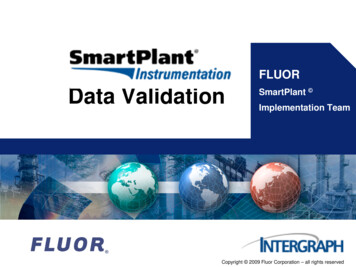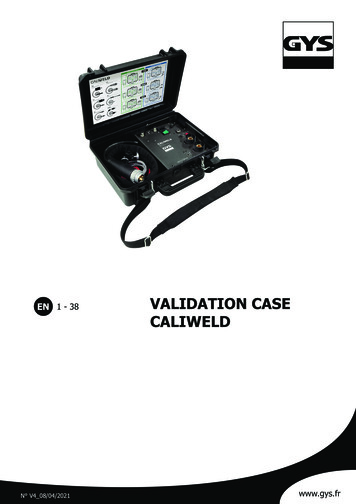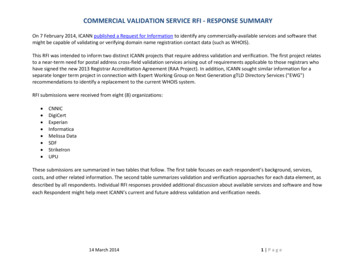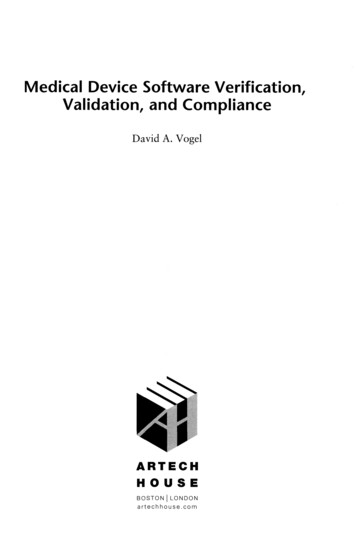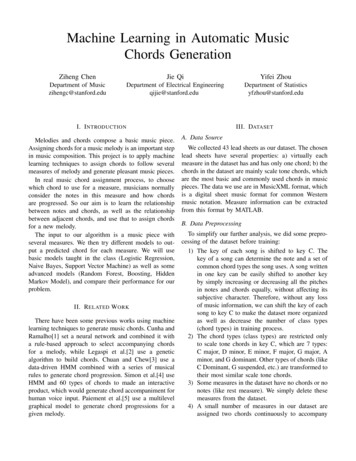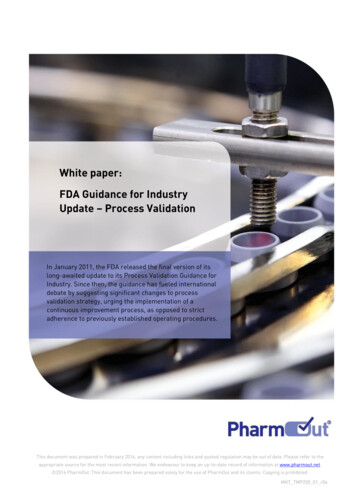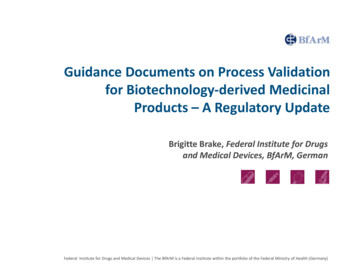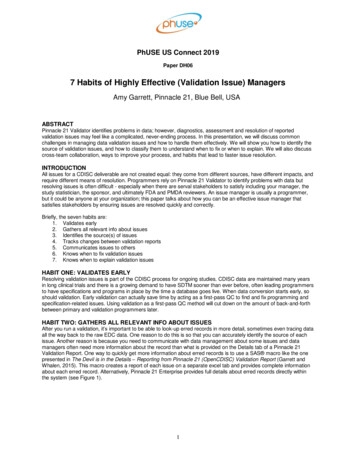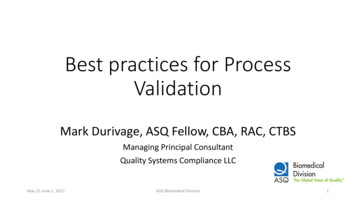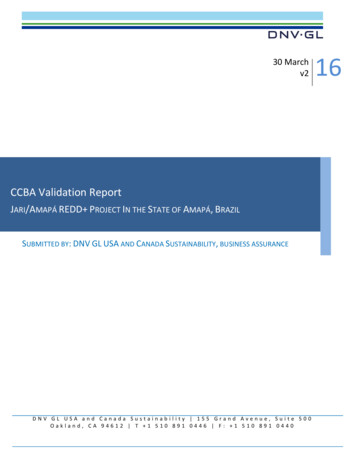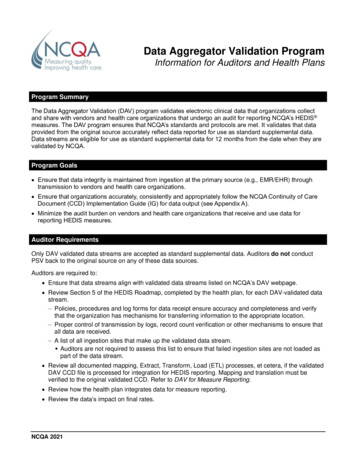
Transcription
Data Aggregator Validation ProgramInformation for Auditors and Health PlansProgram SummaryThe Data Aggregator Validation (DAV) program validates electronic clinical data that organizations collectand share with vendors and health care organizations that undergo an audit for reporting NCQA’s HEDIS measures. The DAV program ensures that NCQA’s standards and protocols are met. It validates that dataprovided from the original source accurately reflect data reported for use as standard supplemental data.Data streams are eligible for use as standard supplemental data for 12 months from the date when they arevalidated by NCQA.Program Goals Ensure that data integrity is maintained from ingestion at the primary source (e.g., EMR/EHR) throughtransmission to vendors and health care organizations. Ensure that organizations accurately, consistently and appropriately follow the NCQA Continuity of CareDocument (CCD) Implementation Guide (IG) for data output (see Appendix A). Minimize the audit burden on vendors and health care organizations that receive and use data forreporting HEDIS measures.Auditor RequirementsOnly DAV validated data streams are accepted as standard supplemental data. Auditors do not conductPSV back to the original source on any of these data sources.Auditors are required to: Ensure that data streams align with validated data streams listed on NCQA’s DAV webpage. Review Section 5 of the HEDIS Roadmap, completed by the health plan, for each DAV-validated datastream.– Policies, procedures and log forms for data receipt ensure accuracy and completeness and verifythat the organization has mechanisms for transferring information to the appropriate location.– Proper control of transmission by logs, record count verification or other mechanisms to ensure thatall data are received.– A list of all ingestion sites that make up the validated data stream. Auditors are not required to assess this list to ensure that failed ingestion sites are not loaded aspart of the data stream. Review all documented mapping, Extract, Transform, Load (ETL) processes, et cetera, if the validatedDAV CCD file is processed for integration for HEDIS reporting. Mapping and translation must beverified to the original validated CCD. Refer to DAV for Measure Reporting. Review how the health plan integrates data for measure reporting. Review the data’s impact on final rates.NCQA 2021
2DAV Program—Information for Auditors and Health PlansIf an organization sends a validated data stream to a health plan in addition to data sources that have notbeen DAV-validated, the auditor must treat the unvalidated data sources as nonstandard supplemental data.If data were previously audited, the auditor may use previous audit findings.DAV for Measure ReportingThe final validated output of the DAV program is CCDs that comply with HL7 C-CDA R2.1. To supportstandard supplemental data for HEDIS reporting, only validated CCDs from validated sources may beshared with organizations.Organizations must use validated CCDs for HEDIS reporting and must complete Section 5 of the HEDISRoadmap, as with all supplemental data. Processing of the validated CCD (e.g., into a vendor file layout) ispermitted, but must follow the following criteria, if applicable, which will be reviewed by a HEDIS ComplianceAuditor: Document mapping. Document extract-transform-load (ETL) processes. Maintain an original copy of the CCD.Auditors must examine processed data back to the validated CCD files for a minimum of five cases.Program QuestionsRefer to Appendix B for DAV definitions.Send all inquiries through PCS via My NCQA. Select the Product/Program Type as HEDIS Audit; select theGeneral Content Area as Data Aggregator Validation Program.If you’d like to purchase the 2021 Data Aggregator Validation Program manual (this is not required), you canfind it here: NCQA Data Aggregator Validation - HEDIS & Quality MeasurementNCQA 2021
DAV Program—Information for Auditors and Health Plans: Appendix A3APPENDIX ACONTINUITY OF CARE DOCUMENT IMPLEMENTATION GUIDEOverviewThis specification is a constraint on HL7 C-CDA R2.1 and references key Continuity of Care Document(CCD) templates to generate a CCD document with information that supports quality measure reporting(e.g., HEDIS measures).Templates and references to examples are based on the C-CDA R2.1 CCD, which is backward compatiblewith CCD R1.1. Refer to Table 1 for a summary of templates within the scope of the DAV program.The version of C-CDA R2.1 referenced in the CCD IG is in the June 2020 errata package available on theHL7 C-CDA product page.An online navigation tool allows searches of C-CDA by description, template OID or conformance number.Find specific CDA examples developed and approved by the HL7 Structure Documents Work Group at HL7C-CDA Example Search.The reason and rank entries from the Quality Reporting Document Architecture Category I are includedbecause there is no CCD equivalent available. Refer to Table 2 for the templates. These templates areallowed in CCD due to its “open” template design.The version of QRDA Category I referenced in the CCD IG is STU 5.2 with errata and is available on theHL7 QRDA product page.No InformationThe CCD includes a nullFlavor of No Information (“NI”) at the section level if a section has no pertinentinformation.A non-relevant section may include this nullFlavor. The HL7 SDWG approved this approach after publicationof C-CDA R1.1; the ONC Cures validator (https://site.healthit.gov/home) supports this change.NCQA 2021
4DAV Program—Information for Auditors and Health Plans: Appendix ATable 1: C-CDA R2.1 CCD TemplatesTemplate TitleTemplate TypeTemplate IDUS Realm -01Continuity of Care Document 8-01Allergy and Intolerances 15-08-01Allergy Concern Act 1Allergy - Intolerance Observation Severity Observation Reaction Observation 1Encounter Activities 1Service Delivery Encounter Diagnosis 1Problem Observation ssessment Scale ctional Status Observation 9Self-Care Activities (ADL and tion Activity 1Immunization Medication 2.16.840.1.113883.10.20.22.4.37Encounters Section (entries required) (V3)Functional Status Section (V2)Immunizations Section (entries required) (V3)Medical Equipment Section (V2)Non-Medicinal Supply Activity (V2)Product InstanceProcedure Activity Procedure (V2)Product InstanceNCQA 2021
DAV Program—Information for Auditors and Health Plans: Appendix ATemplate TitleMedications Section*Template TypeTemplate 09Medication 06-09Medication 06-09Medication 2.16.840.1.113883.10.20.22.2.18:2015-08-01Coverage 08-01Policy 6-09Planned Observation 9Planned -09Product InstancePlanned ned Immunization Activity d Medication Activity 6-09Medication 14-06-09Immunization Medication 15-08-01Problem Concern Act Problem Observation Procedure Activity -06-09Procedure Activity Observation (Diagnostic Studies -01Mental Status SectionAssessment Scale ObservationPayers SectionPlan of Treatment Section (V2)Problem Section (entries required) (V3)*Procedures Section (entries required) (V2)Results Section (entries required) (V3)*Result Organizer (V3)NCQA 20215
6DAV Program—Information for Auditors and Health Plans: Appendix ATemplate TitleResult Observation (V3)Template TypeTemplate cial 5-08-01Vital Signs Section (entries required) 08-01Vital Sign Observation 9Vital Signs Organizer 1*Required section.NCQA 2021
DAV Program—Information for Auditors and Health Plans: Appendix A7Table 2: QRDA STU5.2 TemplatesTemplate TitleTemplate TypeTemplate 9-12-01Reason ObservationThis template describes the rationale for performing (or not performing) an action.RankRank is an item’s position in a hierarchy, defined by an integer to indicate its relative importance. In the CCDIG, rank indicates the principal diagnosis.NCQA 2021
8DAV Program—Information for Auditors and Health Plans: Appendix BAPPENDIX BDEFINITIONSDefinitionsingestion siteUnique data sources (e.g., provider, practice or hospital) contributing to a cluster.clusterA group of similar ingestion sites by EMR type and care setting that contribute to adata stream.data streamOne or many clusters processed through all standards for validation.validated datastreamThe specific data stream of one or many NCQA-validated clusters. After data areprocessed through all validated standards, including PSV, the data stream can beused as standard supplemental data and for other clinical and quality programs.responsible partyThe organization seeking validation of the data stream, contractually obligated toconduct PSV and validation of the data stream and responsible for identifying andalerting NCQA to changes that could impact validity or usability.standardSpecific process and documentation requirements (e.g., PSD 1.0, ODI 2.0) thatmust be met to ensure accuracy and integrity of the data stream.data partnerAn organization that does not conduct PSV, but may meet other DAV standardsand support responsible parties for validation of the data stream.NCQA 2021
Ensure that data integrity is maintained from ingestion at the primary source (e.g., EMR/EHR) through transmission to vendors and health care organizations. Ensure that organizations accurately, consistently and appropriately follow the NCQA Continuity of Care . 2015-08-01 Continuity of Care Document (CCD) document 2.16.840.1.113883 .

